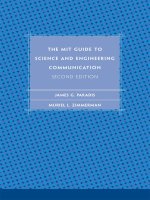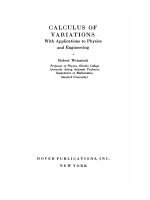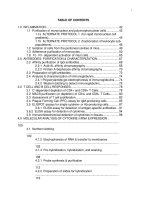MIT Guide to Science and Engineering Communication 2ed - J Paradis (MIT 2002) Episode 8 potx
Bạn đang xem bản rút gọn của tài liệu. Xem và tải ngay bản đầy đủ của tài liệu tại đây (717.07 KB, 25 trang )
Figure 11.4
A compliance matrix shows proposal evaluators that the document responds to
requirements in the request for proposal (RFP).
Proposals 165
(a)
(b)
(h for notice of upcoming solicitations. In
a reasonably typical scenario, advance notice of a solicitation will appear
on March 6, the RFP will reach the potential bidder on September 25,
and the completed proposal will be due on November 1. Acade mic pro-
posal writers receive mailings from potential sponsors, so they can plan
proposal responses many months in advance.
Nevertheless, proposals are usually written under pressure, when
you ha ve technical work as well as proposal writing to do. Often in a
matter of one or two weeks, a project concept must be refined, a team
assembled, and a detailed document prepared. This complex process
must be thoughtfully sequenced and coordinated to prevent a waste of
resources. It must include steps that the proposal group may actually
enjoy doing, like technical brainstorming, and steps that many group
members will resent, like leaving valuable time for proofing, printing,
binding, and delivery.
When you work out a routine for proposal writing, you need to allo-
cate time for each step by first identifying the submission deadline and
then backing up to the present (Figure 11.5a, b). Many proposal writers
use project management software to track their progress. The best-made
schedules will change. You may need more time than you had antici-
pated to prep are a budget section and considerably less time to prepare a
list of related contracts.
Allocate Team Responsibilities
Managing a group preparing a proposal can be as challenging as man-
aging the research itself. In academic settings, the group writing the pro-
posal will probably be the same one slated to carry out the work. Most
research universities have offices of contracts and grants to give advice at
various stages. In industrial settings, many more people are part of pro-
posal preparation. In addition to the research group, proposal managers,
budget analysts, technical managers, artists, and technical writers are
Figure 11.5
Many proposal preparation teams plan and track their tasks with Gantt charts.
This group has planned twenty-three days for writing and three days for pro-
ducing their proposal (a). Note, however, that the technical work that is the
subject of the proposal goes on at the same time (b). Few engineers or scientists
are able to devote full time to proposal writing!
Proposals 167
often involved. The team’s ability to collaborate is a decisive factor in the
success of both the proposal document and the funded work.
We think that groups work best when they meet often and when their
assignments and responsibilities are visible and explicit. One person
should agree to be proposal manager. Every group member should
read the entire RFP. Every member should receive an annotated pro-
posal outline with specific allocation of responsibility. Every member
should know who is responsible for each part of the proposal. Annotated
calendars, printouts of graphics charting project progress, and the com-
pliance matrix should be displayed in prominent places. The group
should establish regular meeting schedules, and members should
receive explicit instructions about preferred format, writing, and design
strategies.
In some industrial settings, the storyboarding method is used to man-
age collaboration. The proposal manager prepares an outline to match
requirements in the RFP, and each member of the writing group tak es
specific portions of the outline. Authors receive preprinted forms, each
representing a two-page spread in the final proposal. They fill in the left
side of the storyboard with a thesis sentence and notes about the point to
be made in response to their section of the outline. They fill in the right
side of the form with rough drawings of illustrations to support the point
as well as captions for the illustrations (Figure 11.6). After pinning their
storyboards to the wall of a large room, team members can review the
document as they walk and talk their way around the room (Figure
11.7).
Storyboarding is helpful be cause it facilitates revision. Each two-page
module can easily be improved withou t changes to the rest of the docu-
ment. The process also facilitates review as it makes inconsistencies ob-
vious. It coerces writing that is responsive to the requirements of an RFP,
and it makes effort (or lack of effort) visible: Blank spaces will show
where a delinquent engineer’s storyboards should be. In addition, story-
boarding produces an efficient document design: Tables and figures are
always located on the right facing page, directly across from the text
passage in which they are discussed. Yet some proposal writers find the
method ov erstructured. To be successful, storyboarding requires a firm
commitment from a prop osal manager, because it never just happens.
168 Proposals
Prepare Style and Format Guides
The most efficient way to achieve consistency in proposals is to pre-
pare style and format specifications. Style guides may be as informal as a
single-page handout asking all writers to do three things: (1) use the
active voice, (2) put important ideas in the first sentences of paragraphs,
and (3) use a hyphen when ‘‘strip-mine’’ is a verb. Or they may be
lengthy manuals covering numerous issues such as how to prepare math-
ematical material; preferred spellings, abbreviations, and acron yms; and
grammar, cap italization, and hyphenation. The alternative to establish-
ing style guidelines in advance is to establish and apply them at the end,
when editing time is usually better spent imposing consistency in me-
chanical matters such as renumbering equations.
Consistency in format is at least as important as consistency in style,
showing proposal evaluators that you have prepared the document with
Figure 11.6
This storyboard is a draft of text (left) and graphics (right) for two pages of the
Atlas proposal. (Courtesy Hugh Marsh.)
Proposals 169
care. Your team may find it helpful to distribute samples of finished
pages, wit h heading styles and sizes highlighted, and samples of com-
pleted illustrations. Simple format instructions such as ‘‘Use Courier font
in 10 point, design all figures to fit either one-half page or a full page,
and design all figures to be read vertically’’ may be all you need to ensure
that the proposal looks carefully produced.
Format specifications can be stored electronically. You can create
templates of basic pages with predefined styles of headings, type sizes,
fonts, margins, spacings, indentat ions, and other features. Routines that
manage numbering systems for elements like headings, references, and
equations are widely available.
Facilitate Electronic Submission
Many funding agencies now require electronic submission of proposals.
The National Science Foundation paperless proposal and award initia-
tive is called FastLane, an interactive real-time system used to conduct
NSF business over the Internet (h />htmi). Principal Investigators (PIs) at registered FastLane institutions
prepare their proposals on-line , and authorized co-PIs can access and
Figure 11.7
Proposal team members pin their storyboards to the wall, and the entire docu-
ment is reviewed before the final draft stage. (Courtesy Hugh Marsh.)
170 Proposals
modify the proposal. Access is also granted to the proposers’ Sponsored
Research Office for comment and approvals. An electronic proposal is
not processed, however, until the cover sheet and certification page are
printed, signed, and mailed to NSF.
Proposal Content
Front Matter
Letter of Transmittal A letter of transmittal (or a memo, in the case
of an internal document) should always accompany your proposal. As
shown in Figure 11.8, the letter should identify the solicitation you are
responding to and give a brief overview of proposal contents.
Cover If a preprinted cover sheet is supplied in the RFP, be sure to use
it. If yo u need to design your own cover, provide the project title and
name the proposing organization, the potential sponsor, the date, and
program solicitation number (Figure 11.9). A proposal title should be
brief, informative, and intelligible to a scientifically literate but nonspe-
cialist reader. Take advantage of the visibility and prominence of the title
to teach reviewers about your idea and to sell its advantages.
Project Summary In a project summary, briefly describe the problem
addressed in the study, the methods used, and the expected results.
Summaries are typically one to three pages. Think of the summary as a
freestanding document, one that may actually have much wider circula-
tion than the rest of the prop osal. Be sure that readers can profit from
the summary without reading the main body of the proposal: Do not
refer to tables or figures that appear elsewhere; define acronyms and
avoid abbreviations. Some RFPs ask that the summary be written at a
level appropriate for an audience of educated but nonspecialist readers.
In these cases, summaries of successful proposals may be used in agency
reports and news releases.
Some RFPs ask for both summary and abstract. Like a summary, an
abstract may have a life of its own and be read by far more readers than
those who evaluate the proposal. Abstracts are typically briefer than
summaries (one paragraph of approximately 150 words), and they are
Proposals 171
Figure 11.8
A letter of transmittal should identify the competition you are entering and pro-
vide a capsule version of proposal contents.
172 Proposals
Figure 11.9
The cover page is the most prominent element in a proposal document. An in-
formative title and attractive design can help to persuade reviewers of the value
of your idea.
Proposals 173
written for the same specialist readers who will read the proposal (see
discussions of abstracts in Chapters 13 and 14).
Table of Contents The table of contents serves as an organizational
map of your proposal, helping evaluators locate relevant material. In the
table of contents, list section headings and name the elements contained
in appendixes. Provide a page number for each element. Many proposal
writers provide two tables of contents: a brief version with first-level
headings only and an expanded version with headings at second, third,
and even fourth or fifth levels.
List of Figures and Tables List all figure and table titles and their page
numbers. The list of figures and tables is highly visible and widely used
by technical readers. As with headings, you can use titles to inform and
persuade. Instead of writing perfunctory titles like ‘‘Filtering system,’’
you can write titles that lead evaluators to the conclusion you hope they
will reach: ‘‘Filtering system has been modified to exceed requirements.’’
Compliance Matrix Whether or not one is called for in the RFP, a
compliance matrix (Figure 11.4) indicates that you have paid careful
attention to the sponsor’s requirements. It also tells reviewers where
they can find your response to each required section.
Body of Proposal
Technical Section In the technical section, identify the problem and its
significance, state the objectives of the proposed investigation, and pro-
vide a clear statement of the work to be undertaken. Outline your ap -
proach to the research, noting significant alternatives and your reasons
for not pursuing them. In man y cases, you are also expected to review
earlier work and related studies; advice about preparing such reviews is
provided in Chapter 14.
Management Section The management section names the personnel
who will do the proposed work and the facilities in which the work will
be done. It also contains highly detailed task breakdowns and work
schedules. Management sections are the place to argue for the qualifica-
174 Proposals
tions of the principal investigators and their associates. Relevant high-
lights of curricula vitae can be summarized, and lists of previous related
contracts can be provided.
Budget In your budget, provide cost details for salary and benefits, and
justify each number. Include indirect costs (overhead), as well as direct
costs like materials, equipment, salaries, and travel. Many sponsors pro-
vide preprinted sheets for budget calculations; to comply with the RFP,
you must use those sheets to record your request.
Appendixes
References List references to previous papers, documents, and discus-
sions that have been used in preparing the proposal.
Supporting Details When appropriate, include items like curricula
vitae, copies of publ ications of principal investigators in areas related to
the proposal topic, lists of previous related contracts, letters of reference,
and detailed and oversized figures and tables.
Business Plans
Engineers and scientists are increasingly interested in raising money to
start their own technical enterprises. In such cases, they need to write a
business plan, a specialized form of proposal pitched to an audience of
investors or bank loan officers. A business plan has much in common
with a standard proposal: It must demonstrate keen understanding of the
project you wish to undertake as well as of your qualifications for ac-
complishing what you say you will. Like a formal proposal, a business
plan is a detailed blueprint for the work you will do and the time in
which you will do it. The major difference is in purpose. While the
explicit goal of a research proposal is likely to be an enhanced under-
standing of some unsolved problem in scienc e or engineering, the explic it
goal of a business plan is to raise money for an enterprise that will pro-
duce a financial profit. For that reason, business plans require focused
explanations of how your technical plan enables you to do something
that others can’t (or don’t) do and that customers will be willing to pay
Proposals 175
for. You need to understand the market for your concept as well as
the competition, and you need to provide solid evidence that you and
other members of your team have the experience and credibility to use
investors’ money wisely.
Format for a business plan can vary, but the modules in Figure 11.10
are typical. Many business plan consultants advise authors to treat the
executive summary as the most important section of the business plan. It
will be more widely read than any other section and should contain a
self-sufficient, well-reasoned case for providing financing for your proj-
ect. In many cases, a face-to-face meeting with potential investors is also
required. You need to be able to speak enthusiastically about the critical
elements of your venture and to be prepared for highly critical questions.
Stressing the Strengths of Your Ideas
Because a proposal is a sales document, you need to be able to identify
and emphasize the features and benefits of your idea. At the paragraph
and sentence level, in section previews, in well-designed graphics, and in
captions to illustrations, skillful proposal writers can reinforce powerful
arguments for the value of their plan. Instead of writing a perfunctory
caption like ‘‘Project Placement,’’ you can write something that may help
evaluators to reach positive conclusions about the plan described: ‘‘Proj-
ect Placement Takes Maximum Advantage of the Expertise of Three Re-
search Groups.’’
Keep in mind that proposals are likely to be reviewed by readers with
widely different interests and levels of technical understanding. Because
each reviewer will be interested in different aspects, plan to repeat key
ideas and make sections of your proposals as nearly freestanding as
possible. While full details of the work are provided in the technical vol-
ume, a budget analyst may be reading only the cost section. Be sure to
provide at least a capsule of information about key aspects of your proj-
ect in every volume of the proposal.
Give reviewers the impression that you are confident of success by
using the present tense for general descriptions and the future tense for
actions in the future. Write as though the funds and approvals have been
granted. A proposal style dependent on conditional verb forms is awk-
ward: ‘If and when funding were to be granted, we would at the time of
176 Proposals
Figure 11.10
Standard format for a business plan. The executive summary may be more
widely read than any other section.
Proposals 177
the second phase of the project develop test equipment.’’ Compare ‘‘In
Phase 2 we will develop test equipment.’’
In some particularly competitive industrial settings, proposal groups
create a ‘‘win theme matrix.’’ They list strong thematic phrases or sen-
tences that argue for the merits of their idea—and they write these
phrases into every section of the proposal, us ing the matrix as a checklist
to assure that they have repeated their win themes.
Preparing an Attractive Document Package
Though proposal evaluation schemes never award any points for visual
attractiveness, the way a document looks can convey a powerful sense of
your professionalism and competence. Even when a proposal is written
in accord with rigid and challenging page limits, its design elements can
facilitate navigat ion through the document. Tabbed section divide rs and
informative page headers help busy reviewers read your document effi-
ciently. Judicious selection of type styles and sizes will signal what ele-
ments are more important than others. A heavyweight or even laminated
proposal cover may assure that your document will hold up to multiple
reviews. A logo, proposal title, and organizational name on every page
will serve as a reminder to reviewers of who you are and what you
are selling. Successful proposals are often exceptionally attractive docu-
ments, with numerous foldouts, photographs, and other artwork set on
pages designed with great care.
But in selecting design options, be sure to read the RFP for guidelines.
Many funding agencies provide explicit instructions for utilitarian de sign
and packaging.
Your Proposal Writing Program
Resubmitting
It is highly unlikely that every proposal you write will be funded, and it is
hard to know exactl y why one proposal is successful and another is not.
If your project is denied, you can still get some benefit from the work
you have done by finding out why, a process called ‘‘debriefing.’’ The
amount of information you can receive about the deliberation process
178 Proposals
varies from agency to agency, although the identity of reviewers is never
revealed.
If you have submitted your proposal to the National Science Founda-
tion, you will automatically receive a debriefing. When the decision is
made, the principal investigator receives copies of reviews (excluding the
names of reviewers), summaries of review panel deliberations, a descrip-
tion of the process by which the proposal was reviewed, and details
about the decision, such as number of proposals and awards. Other
agencies will provide debriefings with a written request, usually within
30 days after the announcement of the final selections.
Depending on what you learn in your debriefing, you may want to
resubmit the same proposal or one substantially like it in a future com-
petition. Possibly it was technically excellent but did not fit the agency’s
research priorities for that year. If you identify weaknesses in your proj-
ect proposal, consider ways of salvaging the concept. In some instances,
you may focus the proposal on another area and apply to another
agency.
Creating Document Databases
If you regularly write proposals, you will want to create computer files
of standard information, text, and graphics. Many proposal sections—
including curricula vitae, drug-free workplace plans, related experience,
and management history—are likely to be required in nearly the same
form for any project you may bid on. Instead of co mpiling and typing
these chunks of standard text each time a proposal is created, you can
record and save them as separate files that can be quickly tailored and
inserted into new documents as needed (Figure 11.11).
You will, of course, want to review the old files as you use them, but
they are easily updated to contain the most relevant text and graphics.
An additional benefit is that these data files can be made available for use
by other pro posal writers in the organization.
Staying Informed
A proposal-writing program requires careful planning. You must know
the needs of your discipline; you must have good information on funding
sources and their requirements. Keep a file of agency announcements,
Proposals 179
RFPs, and NPIs. Keep another file of new project ideas that occur to you
or to members of your team. Articles from the literature may suggest new
research possibilities for your fie ld. To develop new ideas, go to confer-
ences, check the Annual Register of Grant Support (R. R. Bowker) and
keep up with the literature. Look for technological developments that
make new research feasible; some researchers sift through patent lit-
erature for ideas. The Federal Research in Progress Database (FEDRIP)
provides access to ongoing federally funded projects in physical and
life sciences as well as engineering (h The
home pages of agencies like the National Science Foundation (hhttp://
www.nsf.govi), the National Institutes of Health (hi),
and the Department of Transportation (h i) are good
sources for proposal announcements and deadli nes.
Figure 11.11
Of 11 sections included in proposal by writers at Amber Engineering, Santa Bar-
bara, CA, 5 are standard in all proposals, 3 are modified, and only 3 are new.
Reusing stored text will yield improved accuracy in content and consistency in
format. (Courtesy of Stan Laband.)
180 Proposals
If you depend on the support of sponsored research, you must have a
long-range funding strategy. If you are writing proposals in June for next
winter’s support, you’re in trouble. Most research proposals take from
four to nine months for revie w, and you may need to be thinking two to
three years ahead. Track new project possibilities and funding sources.
Keep agency application deadlines prominent on your work calendar ,
and meet each annual application deadline with one or more new pro-
posals. A professional researcher may have five to ten proposals circu-
lating at once. To write proposals on this scale, you obviously need to
work out a detailed application routine.
Proposals as Part of a Continuum
Proposals are crucial documents in the production of scientific knowl-
edge, providing access to the funding and approvals that make research
possible. When proposals are successful, they create more communi-
cation tasks. They lead to writing projects such as progress reports, final
reports, conference proceedings, and journal articles. Each document
form disseminates information to wider and wider audiences.
Proposals also create occasions for speaking about your ideas. When
you work on a proposal, be prepared to talk persuasively about the
project, on occasions ranging from informal telephone conversations and
hallway meetings to formal presentations with potential sponsors. In
active professional settings, you should always be primed to talk about
your research and argue for your position.
Proposals 181
This page intentionally left blank
12
Progress Reports
Audiences
Formats and Schedules
Organization
Design and Distribution
Document Databases
o
You’re in a bind. Your third progress report is due tomorrow, and the
news is bad. Less than halfway into a 12-month project, you’ve fallen
behind schedule and used close to half your budget. You still hope to
compensate for lost time and extra expenses, but now you must tell your
manager about these difficulties. Unfortunately, you’ve already com-
pounded your problem. Last month, you avoided reporting the project’s
deficiencies, hoping that you could solve the problems quickly. Your
manager will be unpleasantly surprised that your last report was overly
optimistic.
Progress reports are always intermediary, never final documents. They
track, evaluate, and archive the work of science and engineering. Prog-
ress reports are bridges, spanning the time between the beginning and the
end of a project—from the projections in the proposal to the reality of
the work.
In the proposal that initiates a project, you describe tasks and activities
that have not yet happened as though you know what will happen at
every stage of the work. You estimate, guess, project. Your proposal has
minimized ambiguity. Instead, you have described a predictable series of
events leading to a successful outcome.
In contrast, you write a progress report as you do the work. Your
report might tell the same story as the proposal, or it might tell a differ-
ent one. A proposal says, ‘‘This is what will happen’’; a progress report
says, ‘‘This is what actually happened.’’ The baseline against which prog-
ress is measured is what you said would happen: at what cost, in what
time frame, with what research ers involved, and with what deliverables
delivered.
Progress reports may be formal documents written to satisfy external
funding sources, or they may be informal documents that track and
monitor employee activity within an organiz ation. In many industrial
settings the progress report (sometimes called a status report, a morning
report, a briefing, or a weekly) is one of the most frequent and routine
pieces of writing for technical professionals. Typically, each researcher
prepares an account of activities for a specified period and passes the
account upward to a manager. The manager writes a summary progress
report for an entire department and passes this more comprehensive
account upward, to a manager at a higher level. At the highest level , a
manager will be able to report on progress for numerous projects.
Audiences
Readers of progress reports are likely to be knowledgeable about the
technical areas you describe and also deeply concerned with the status of
activities. They want to know what has been done and what needs to be
done, what problems you have encou ntered, and how likely you are to
stay within a previously agreed-upon budget and schedule. They want to
know if you are spending their money and your time in ways that will
yield desired outcomes.
Because such readers are typically worried about the project, writers
sometimes feel constrained to use the progress report to allay anxieties
rather than record problems. But the progress report is the vehicle for
assessment, evaluation, and possibly for renegotiation. Your report may
cause the project to take a new direction, with revised goals. You might
be tempted to use the progress report for claiming credit for your
achievements or crowing about the excellent match between your pro-
jections and what has actually happened. Don’t. It is safer to report
184 Progress Reports
achievements modestly and to report problems as soon as possible.
Progress reports have been entered into legal proceedings. You are on
solid ground if you record what has happened, not what you want your
sponsor to think has happened. Recognize that authors of progress
reports are not always able to record desirable advances toward the
orderly achievement of a goal.
Your progress report should address the concerns of your readers by
including a section devoted to assessment and evaluation. A genuinely
useful progress report will include interpretation of results as well as raw
numbers.
Formats and Schedules
In writing a proposal, you follow instructions provided in the request
for proposal (RFP), or you create a responsive format of your own. In
the same way, a progress report follows instructions provided by your
sponsor or your supervisor, using the forms and formats specified, or
you create your own functional document. For many government con-
tracts, the frequency of progress reports will be specified in a contract
data requirements list (CDRL), with details of form, length, and style
provided in a data item description (DID).
Progress reports vary widely in form and length, from a one-page
memo, letter, or preprinted form to a several-hundred-page bound vol-
ume with a separately bound appendix. In tracking a multiyear project,
progress reports are often long at some stages, perhaps annually, and
very brief at others.
Progress reports tend to be less formal than proposals or research
reports. Each one summarizes progress since the preceding report, and
the earlier report is always summarized, subsumed, and superseded by
a new one. Progres s reports have some elements in common with pro-
posals and formal reports, but they are always distinguished by their
focus on
Project status
Measurement of achievements against projections
Problems encountered
Work completed
Progress Reports 185
Work remaining
Evaluation
Figure 12.1 lists possible elements in a progress report. In selecting
elements, remember that all progress reports in a series should have the
same format. For example, if you have included a section called ‘‘Prob-
lems Encountered’’ in the first report, you should include the secti on in
the second report, even if all you have to say is that you have encoun-
tered no new problems.
The schedule for submitting progress reports is established in a
proposal (Figure 12.2) or by organizational practice. Reports may be re-
quired weekly, monthly, bimonthl y, annually, or on some other sched-
ule. Often, one kind of report is required weekly while another kind
is required semiannually. Whatever the schedule, you must follow it
strictly, even if your work has not gone as you had planned.
Organization
Readers review progress reports to get answers to their questions about
project status: perhaps monitoring employee productivity, perhaps keep-
ing an eye on costs. A well-designed pro gress report will be modular,
with modules clearly labeled, so that readers can skip over sections they
do not need to read and proceed quickly to sections that interest them.
No reader will want to spend time hunting for information. Use headings
for each new topic area, and provide a table of contents to enable skim-
ming. Consider using labeled tabs to divide and mark sections in longer
reports.
Figure 12.3 illustrates alternative ways to present information in a
progress report. Progress rep ort 1, the more conventional of the two, is
organized chronologically, with the emphasis on the current state of the
project. In this version, the tasks are subordinated. Progress report 2 is
organized by task, and in this version the current state of the project is
subordinated. If a sponsor has not given explic it instructions for prepar-
ing a progress report, you can choose a presentation style that best re-
flects the work. Writing style in the narrative sections of progress reports
is sometimes relatively formal, resembling the style of a proposal or fina l
report, and sometimes informal, with phrases acceptable in place of
complete sentences.
186 Progress Reports
Figure 12.1
Possible elements in a formal progress report. If you need to prepare a series of
progress reports for a single project, use the same elements and formats for each.
Progress Reports 187
Figure 12.2
Five progress reports are scheduled during the 15-month period of this project.
The schedule was established in the proposal.
Figure 12.3
Several organizational patterns are appropriate for reporting progress. Progress
Report 1 emphasizes the overall status of the project; Progress Report 2 empha-
sizes the status of individual tasks.
188 Progress Reports
Design and Distribution
Progress reports often have more graphic than narrative information.
Figure 12.4 displays the tasks defined in the proposal and provides a
rapid view of the status of the project, showing which tasks are com-
pleted and which are not. Establish one style for graphics to chart and
track your progress. Use the same graphic forms for each progress report
in a series.
Many widely available software packages can be used to create
spreadsheets, tables, and figures, so that monthly or quarterly reports
can be easily compiled by updating the last report. Photographs provide
vivid and dramat ic information ab out progress on some kinds of proj-
ects. Many organizations now ask for electronically submitted progress
Figure 12.4
Good graphics for progress reports show what was supposed to be accomplished
and what actually happened. They serve as planning tools for the research group
as well as for project sponsors.
Progress Reports 189









